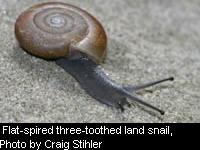Rare and Endangered
Species Update
By Craig Stihler
Bald Eagle and Peregrine Falcon
Although the weather of spring 2003 resulted
in poor nesting success for  the state’s bald eagles that year, they
had a banner year in 2004. There were 16 nesting attempts in 2004, of
which 14 were successful. the state’s bald eagles that year, they
had a banner year in 2004. There were 16 nesting attempts in 2004, of
which 14 were successful.
A total of 25 young eagles were fledged --
the most ever. Of note is the first confirmed nest in Jefferson County
located, appropriately, on the campus of the U.S. Fish and Wildlife Service
National Conservation Training Center in Shepherdstown. A second nest
believed to exist in the county has not been confirmed. Although eagles
are doing well in the Potomac River drainage, no successful nests have
been found in the remainder of the state.
Unfortunately, peregrine falcons are not faring well in the Mountain State.
Cliffs, including all sites where peregrines have nested the past 13 years,
were monitored in 2004, but no peregrine falcons were observed at any
of these sites.
West Virginia Northern
Flying Squirrel
Biologists captured 44 northern flying squirrels during the past year
(18 in fall 2003; 26 in spring 2004) including captures at three new localities
for this squirrel.A recent
capture by DNR biologists in Randolph County and a second capture by Dr.
Ed Michael in Tucker County are low elevation records for this squirrel
at just over 2,300 feet.
Flat-spired Three-toothed Land
Snail
 In 2004, approximately 1,100 acres of habitat for this threatened snail
in Cheat Gorge were purchased by the DNR
to be managed as part of the Snakehill WMA. Two U.S. Fish and Wildlife Service
Recovery Land Acquisition grants helped cover the cost of the property.
Surveys conducted on this tract in 2004 located seven new sites for the
snail. In 2004, approximately 1,100 acres of habitat for this threatened snail
in Cheat Gorge were purchased by the DNR
to be managed as part of the Snakehill WMA. Two U.S. Fish and Wildlife Service
Recovery Land Acquisition grants helped cover the cost of the property.
Surveys conducted on this tract in 2004 located seven new sites for the
snail.
Endangered Bats
Winter bat surveys were conducted at 27 caves last winter. Most of the caves
surveyed were known to harbor small numbers of Indiana bats. A total of
704 Indiana bats were tallied. This represented an increase of 5.6 percent
over the number seen in these caves two years earlier.
Ten summer colonies of Virginia big-eared bats are monitored annually by
DNR biologists using infrared lights and nightvision equipment to count
the bats as they emerge from their cave roosts in the evening. In June 2004,
6,238 big-eared bats were counted at these 10 colonies. This is 4.9 percent
higher than the number tallied at these caves in June 2003.
Mist net surveys were conducted to obtain information on the summer distribution
of bats, especially the Indiana bat. DNR biologists conducted surveys on
Lewis Wetzel WMA, Morris Creek WMA, and Calvin Price and Seneca state forests.
Nearly 200 bats of six species were netted, but no Indiana bats were captured.
Other biologists in West Virginia did capture lactating female Indiana bats
in Boone and Tucker counties. Using radio telemetry equipment, biologists
tracked these bats to their roost trees and discovered the first recorded
maternity colonies in West Virginia!
Endangered Mussels
Much effort was directed to establishing long-term monitoring sites to look
at the condition of mussel beds. Although the techniques varied with the
size of the stream, the goal was to delineate transects across the stream
and survey each transect for mussels. The location of each mussel was marked
with a flag. Biologists measured each mussel, marked them with numbered
tags glued onto the shell, and returned them to the stream. One monitoring
site was set up on the Elk River at a known location for the endangered
clubshell. Of the 902 mussels processed at this site, 58 were clubshells.
The remaining mussels represented 15 additional species.
Two monitoring sites on Hackers Creek in Lewis County had been planned at
known locations for the clubshell. However, when the first site (located
downstream of an I-79 bridge) was visited, 88 percent of the mussels found
were dead. Only 18 live clubshells were located compared to 168 found at
the same site in 1995. Most of the dead mussels had been dead for some time,
probably a year or more in most cases. Our survey then became a salvage
operation. The live clubshells were removed, tagged, and moved to a temporary
holding area.
Biologists visited the second site and established a monitoring site. The
clubshells removed from the first site were translocated to this site.
Mortality at the second site was relatively high, however, and a few species
that were abundant in the past were almost absent this summer. It appears
that chronic problems exist in the watershed. These need to be addressed
to improve stream quality and allow the biological resources to recover.
Similar monitoring sites are being established in other streams where significant
mussel populations occur.
Allegheny Woodrat
Populations of the Allegheny woodrat seem to be declining in the Northeast.
To assess population trends in West Virginia, several long-term monitoring
sites have been established. Unfortunately, because of funding and time
constraints, monitoring of these sites has been sporadic. Several sites
were live-trapped again in 2004. Data suggest that populations at these
sites are similar to those when the sites were trapped seven or more years
ago. DNR biologists will continue to monitor woodrat populations to examine
population trends and possible factors affecting woodrat populations.
Craig Stihler is project leader
of the Endangered Species Program. |

